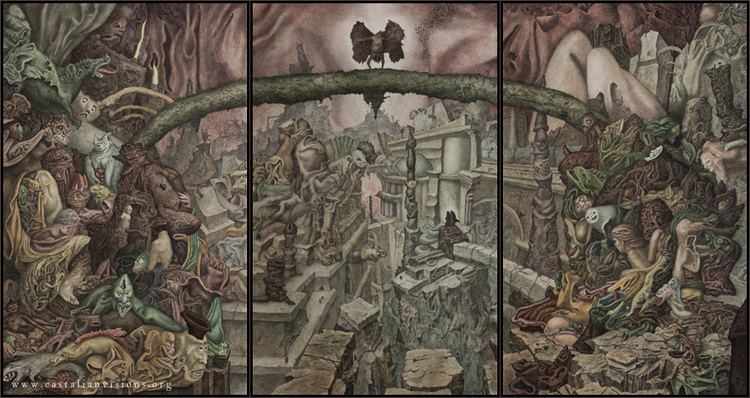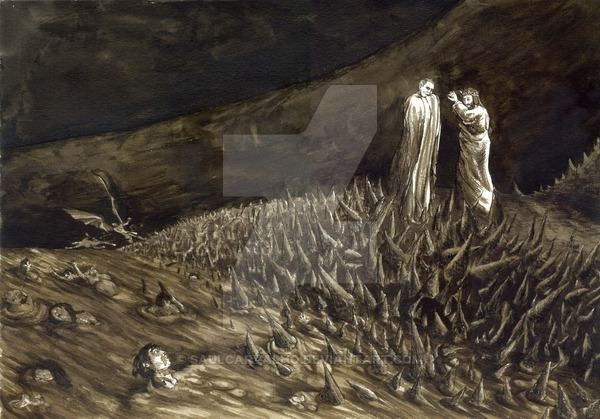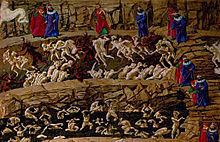 | ||
Malebolge 49 62 ace combat 6 original soundtrack
In Dante Alighieri's Inferno, part of the Divine Comedy, Malebolge is the eighth circle of Hell. Roughly translated from Italian, Malebolge means "evil ditches". Malebolge is a large, funnel-shaped cavern, itself divided into ten concentric circular trenches or ditches. Each trench is called a bolgia (Italian for "pouch" or "ditch"). Long causeway bridges run from the outer circumference of Malebolge to its center, pictured as spokes on a wheel. At the center of Malebolge is the ninth and final circle of hell.
Contents
- Malebolge 49 62 ace combat 6 original soundtrack
- malebolge ace combat 6 ost extended
- The Malebranche
- The Ten Bolgias
- References

In Dante’s version of hell, categories of sin are punished in different circles, with the depth of the circle (and placement within that circle) symbolic of the amount of punishment to be inflicted. Sinners placed in the upper circles of hell are given relatively minor punishments, while sinners in the depths of hell endure far greater torments. As the eighth of nine circles, Malebolge is one of the worst places in hell to be. In it, sinners guilty of "simple" fraud are punished (that is, fraud that is committed without particularly malicious intent, whereas Malicious or "compound" fraud — fraud that goes against bond of love, blood, honor, or the bond of hospitality — would be punished in the ninth circle). Sinners of this category include counterfeiters, hypocrites, grafters, seducers, sorcerers and simonists.

Dante and his guide, Virgil, make their way into Malebolge by riding on the back of the monster Geryon, the personification of fraud, who possesses the face of an honest man 'good of cheer,' but the tail of a scorpion, who flies them down through the yawning chasm that separates the eighth circle from the seventh circle, where the violent are punished. Dante and Virgil plan on crossing Malebolge by way of the system of bridges, but find their path disturbed by many broken ledges and collapsed bridges that were destroyed during the Harrowing of Hell. They must then cross some of the bolgias on foot and even rely on demons to guide them. Eventually, they make it to the inner ledge where after a brief look at the giants, the babbling Nimrod to the hostile Ephialtes and heavily chained Briareus, Virgil convinces the giant Antaeus to lower them down to the ninth circle's frozen lake, Cocytus.

malebolge ace combat 6 ost extended
The Malebranche

Thirteen demons known as the Malebranche, "Evil Claws", guard the fifth bolgia of the Malebolge. Their leader is Malacoda ("evil tail"), while the others are Scarmiglione ("ruffle-haired"), Barbariccia ("curly beard"), Alichino (derived from Arlecchino, the harlequin), Calcabrina ("one who walks on the frost"), Cagnazzo ("bad dog"), Libicocco (a possible mix of libeccio and sirocco), Draghignazzo (maybe from drago, "dragon", and sghignazzo, "guffaw"), Ciriatto (possibly "little pork"), Graffiacane ("scratch dog"), Farfarello (possibly "goblin") and Rubicante (possibly "red" or "rabid"). One of the thirteen was thus not named. They try and trick Virgil and Dante by telling them of a path which does not really exist.
The Ten Bolgias
The ten ditches of the Malebolge, in descending order, are listed thus:
Bolgia One: Panderers and Seducers are punished here. They are forced to march, single file around the circumference of their circle, constantly lashed by horned demons.
Bolgia Two: Sinners guilty of excessive flattery are punished in this bolgia, immersed forever in a river of human excrement, similar to what their flatteries were.
Bolgia Three: Simonists (sinners guilty of selling church offices for personal gain) are punished here. They are turned upside down in large baptismal fonts cut into the rock, with their feet set ablaze by oily fires. The heat of the flames burns according to the guilt of the sinner.
Bolgia Four: Astrologists, seers, sorcerers and others who attempted to pervert God’s laws to divine the future are punished here. Their heads have been twisted around to face backwards, and thus they are forced to walk backwards around the circumference of their circle for all eternity.
Bolgia Five: Grafters (peculators, extortionists, blackmailers and unscrupulous businessmen: sinners who used their positions in life to gain personal wealth or other advantages for themselves) are punished by being thrown into a river of boiling pitch and tar. In addition, should any of the grafters try to escape the pitch, a horde of demons ("Malebranche", meaning "evil claws") armed with grappling hooks and barbs stands guard over them, ready to tear them to pieces.
Bolgia Six: Hypocrites are punished in this circle. They are forced to wear heavy lead robes as they walk around the circumference of their circle. The robes are golden and resemble a monk’s cowl but are lined with heavy lead, symbolically representing hypocrisy. Also, Caiphas, the Pharisee who insisted on the execution of Jesus, is crucified in this circle, staked to the ground so that the ranks of the lead-weighted hypocrites march across him.
Bolgia Seven: This bolgia houses the souls of thieves. The bolgia is also filled with serpents, dragons and other vengeful reptiles that torture the thieves endlessly. The bites of some of the snakes cause the thieves to spontaneously combust, only to regenerate their bodies for further torment in a few moments. They are pursued by the monstrous fiery Cacus. Other thieves are denied human forms and appear as reptiles themselves, and can only assume their true shape if they steal a human shape from another sinner; this involves a very painful transformation for both souls involved.
Bolgia Eight: In this trench, the souls of Deceivers who gave false or corrupted advice to others for personal benefit are punished. They are constantly ablaze, appearing as nothing so much as living, speaking tongues of flame.
Bolgia Nine: Sinners who, in life, promoted scandals, schism, and discord are punished here; particularly those who caused schism within the church or within politics. They are forced to walk around the circumference of the circle bearing horrible, disfiguring wounds inflicted on them by a great demon with a sword. The nature of the wound mirrors the sins of the particular soul; while some only have gashes, or fingers and toes cut off, others are decapitated, cut in half (as schismatics), or are completely disemboweled. Among those who are tormented here is Bertran de Born, who carries around his severed head like a lantern.
Bolgia Ten: Falsifiers, those who attempted to alter things through lies or alchemy, or those who tried to pass off false things as real things, such as counterfeiters of coins, are punished here. This bolgia has four subdivisions where specific classes of falsifiers (alchemists, impostors, counterfeiters, and liars) endure different degrees of punishment based on horrible, consumptive diseases such as rashes, dropsy, leprosy and consumption.
The lower edge of Malebolge is guarded by a ring of titans and earth giants, many of whom are chained in place as punishment for their rebellion against God. Beyond and below the giants lies Cocytus, hell's final depth.
